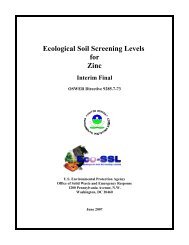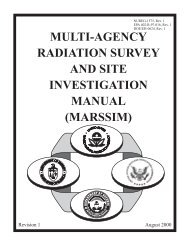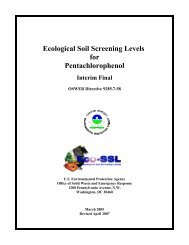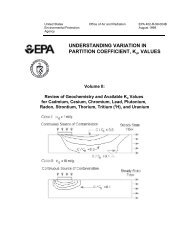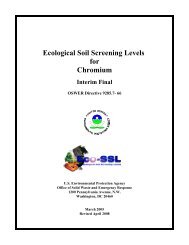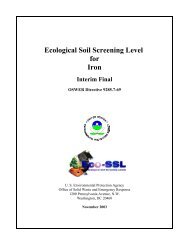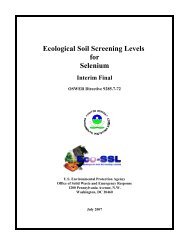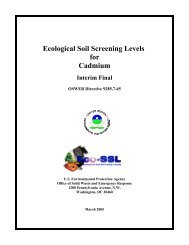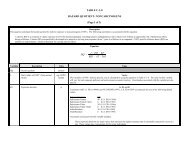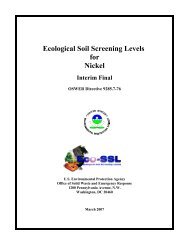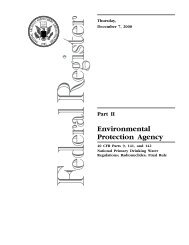Guidance for Conducting Risk Assessments and Related Risk ...
Guidance for Conducting Risk Assessments and Related Risk ...
Guidance for Conducting Risk Assessments and Related Risk ...
You also want an ePaper? Increase the reach of your titles
YUMPU automatically turns print PDFs into web optimized ePapers that Google loves.
Table 2. Site categories<br />
Categories Criteria <strong>for</strong> sites in each category<br />
Operable Units CERCLA actions that have been defined in approved decision documents<br />
(e.g., record of decision, Action Memor<strong>and</strong>um).<br />
Characterization Areas Sufficient in<strong>for</strong>mation exists to recognize that additional CERCLA action is<br />
appropriate.<br />
Remedial Site Evaluation Areas Some existing/historical in<strong>for</strong>mation exists to conclude that the area has a<br />
high potential of being contaminated; however, insufficient in<strong>for</strong>mation<br />
exists to determine if further investigation or remediation is warranted.<br />
Removal Site Evaluation Areas The site meets criteria <strong>for</strong> evaluation to be considered under CERCLA (i.e.,<br />
area is inactive <strong>and</strong> hazardous substances have been released or a threat of a<br />
release exists), but insufficient in<strong>for</strong>mation exists to determine if a removal or<br />
remedial action is necessary.<br />
2.2.1 Site Evaluations<br />
Two types of site evaluations are conducted on the ORR: removal site evaluations <strong>and</strong> remedial site<br />
evaluations (Fig. 2). Removal Site Evaluations are conducted <strong>for</strong> those sites that are considered “newly<br />
discovered”, meaning that they were not previously listed as source areas in Appendix C of the Federal<br />
Facility Agreement <strong>for</strong> the Oak Ridge Reservation (DOE 1992). The removal site evaluation may involve<br />
a limited environmental sampling, but typically it is per<strong>for</strong>med using available analytical data. The<br />
available data are compared with risk-based Preliminary Remediation Goals (PRGs) <strong>and</strong> may indicate<br />
that:<br />
• a removal action is warranted,<br />
• a remedial site evaluation should be per<strong>for</strong>med, or<br />
• no further investigation is needed.<br />
Note: Sometimes, emergency <strong>and</strong> time-critical removal actions are not <strong>for</strong>mally established as projects<br />
until after actions are taken, because of the immediate need to protect human health <strong>and</strong> the environment.<br />
Sites identified as requiring a non-time critical removal or remedial action, however, are established as<br />
projects <strong>and</strong> must then undergo prioritization.<br />
Remedial Site Evaluations are conducted if the available existing/historical data <strong>and</strong> operational<br />
in<strong>for</strong>mation indicate that there is the potential <strong>for</strong> environmental contamination, but insufficient or poor<br />
quality data require the determination of whether additional investigation (e.g., data collection) or<br />
remediation is warranted. In such cases, a comparison of data to risk-based PRGs is a tool project<br />
managers can use to:<br />
• identify data needs <strong>and</strong> limitations (e.g., detection limits are greater than risk-based PRGs),<br />
• focus future sampling <strong>and</strong> analysis on chemicals <strong>and</strong> exposure pathways of potential concern,<br />
• establish appropriate detection limits <strong>for</strong> subsequent environmental sample analysis,<br />
• support a No Further Investigation Determination, <strong>and</strong>/or<br />
• quantitatively support the need <strong>for</strong> additional study.<br />
12



